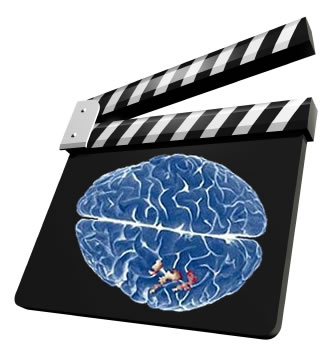Movie Mind Control
 It’s no surprise that movies can light up the brain. After all, they can surprise or frighten us, makes us laugh or cry, create suspense, and much more. What IS interesting from a neuromarketing standpoint is that different directors, content, and styles have a big influence on whether the brain activity of the viewers is similar or dissimilar.
It’s no surprise that movies can light up the brain. After all, they can surprise or frighten us, makes us laugh or cry, create suspense, and much more. What IS interesting from a neuromarketing standpoint is that different directors, content, and styles have a big influence on whether the brain activity of the viewers is similar or dissimilar.
Using advanced functional imaging methods, New York University neuroscientists have found that certain motion pictures can exert considerable control over brain activity. Moreover, the impact of films varies according to movie content, editing, and directing style…
“In cinema, some films lead most viewers through a similar sequence of perceptual, emotional, and cognitive states,” the researchers wrote. “Such a tight grip on viewers’ minds will be reflected in the similarity of the brain activity or high ISC across most viewers. By contrast, other films exert either intentionally or unintentionally less control over viewers’ responses during movie watching. In such cases we expect that there will be less control over viewers’ brain activity, resulting in low ISC.”
To stimulate subjects’ brain activity, the researchers showed them three motion picture clips: thirty minutes of Sergio Leone’s “The Good, the Bad and the Ugly”; an episode of Alfred Hitchcock Presents “Bang! You’re Dead”; and an episode of Larry David’s “Curb Your Enthusiasm.” To establish a baseline, subjects viewed a clip of unstructured reality: a 10-minute, unedited, one-shot video filmed during a concert in New York City’s Washington Square Park.
The results showed that ISC of responses in subjects’ neocortex (the portion of the brain responsible for perception and cognition) differed across the four movies:
- The Hitchcock episode evoked similar responses across all viewers in over 65 percent of the neocortex, indicating a high level of control on viewers’ minds;
- High ISC was also extensive (45 percent) for “The Good, the Bad and the Ugly”;
- Lower ISC was recorded for “Curb Your Enthusiasm” (18 percent) and for the Washington Square Park, or unstructured reality, clip (less than 5 percent)
[From EurekAlert – Film Content, Editing, And Directing Style Affect Brain Activity, Neuroscientists Show]
These experiments are quite fascinating because they show that while in some cases the brains of different individuals react in a consistent and similar manner, in other cases there is very little similarity. This is the challenge of neuromarketing in a nutshell. From a creative standpoint, is it possible to create ads that affect a large share of the viewers in the same way? And, from a neuromarketing analysis standpoint, is it possible to generalize to a larger population from a small number of subjects?
Of course, it’s not essential that a print ad or television commercial create the same kind of brain activity in all viewers. Many ads are designed to let the viewer project himself or herself into the pictured situation, no doubt evoking quite different individual responses. Nevertheless, this study shows that specific techniques are capable of similarly affecting a larger percentage of the viewers than other techniques – a handy thing to know. Now, if you can just get your creative team to emulate Alfred Hitchcock… (No doubt the makers of Axe shower gel are studying clips from Psycho right now… :))
